Triple-amputee Veteran’s GoFundMe to Pay for Trump’s Border Wall Has Raised Over $5 Million in 3 Days
By: J.D. Simkins , Military Times, 20 December 2018
President Donald Trump inspects border wall prototypes in San Diego, California, earlier this year. A Purple Heart recipient has started a GoFundMe drive with the goal of paying for wall construction. (Mandel Ngan/AFP/Getty Images)
An airman who survived the most catastrophic war wounds in the service’s history has started a fundraiser — with a goal of $1 billion — in an effort to pay for the U.S.-Mexico border wall.
Brian Kolfage, a triple-amputee Purple Heart recipient, started the GoFundMe account, “We The People Will Fund The Wall,” amidst ongoing deliberations on how the border wall, a campaign promise of President Donald Trump, will actually be funded.
Trump most recently stated it will be U.S. troops who are tasked with building the wall if Democrats refuse to fund the project, a notion the president emphasized over a series of Dec. 19 tweets discussing border security.
Kolfage, meanwhile, had enough of the delays resulting from back-and-forth funding discussions, and decided to encourage the American public — specifically those who voted for President Trump — to pay for the controversial project.
“If the 63 million people who voted for Trump each pledge $80, we can build the wall,” Kolfage wrote on the fundraiser page. “That equates to roughly $5 billion, Even if we get half, that’s half the wall. We can do this.”
Donations have been pouring in since Kolfage started the fundraiser three days ago, already generating more than $5 million from a total of more than 82,000 donors.
Kolfage says 100 percent of the donations will go toward wall construction, and that a point of contact within the Trump administration has been made to secure "where all the funds will go upon completion.”
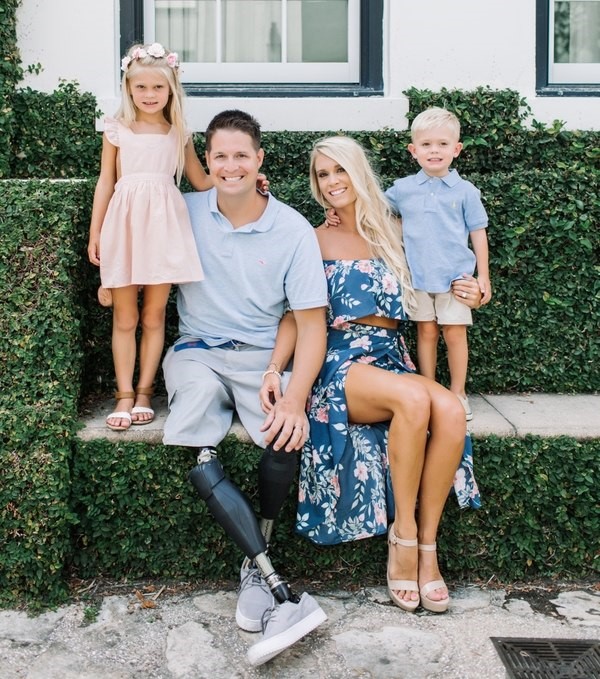
The Kolfage family. (Photo courtesy of Ashley Kolfage)
In the event the goal — or a total sum in the neighborhood of the goal — is not reached, Kolfage says every donor will receive a full refund.
“This won’t be easy, but it’s our duty as citizens,” he says.
Kolfage became the most catastrophically wounded airman to survive his injuries when, while deployed to Iraq on Sept. 11, 2004, a 107mm enemy rocket impacted just three feet away from him.
Both of his legs were instantly shredded, he lost his dominant right hand and his lung collapsed.
Medics would go on to perform hours of life-saving surgery before placing Kolfage on a flight to Walter Reed Medical Center in Washington, where he arrived only 36 hours after being wounded — the fastest medevac to the U.S. from a war zone in history.
Kolfage completed rehab and walked out of the hospital only 11 months after being wounded.
“As a veteran who has given so much — three limbs — I feel deeply invested to this nation to ensure future generations have everything we have today,” he wrote on the fundraiser page.
A donation of this scale to fund a federal project may be unprecedented, but it would not mark the first time the government has accepted large contributions from private donors.
Billionaire David Rubenstein, co-founder of the Washington-based private-equity firm, the Carlyle Group, donated nearly $40 million between restoration and preservation projects on the Washington Monument, the Marine Corps War Memorial’s Iwo Jima sculpture, President James Madison’s historic Virginia residence, Robert E. Lee’s Arlington House and the White House Visitor Center.
J.D. Simkins is a writer and editor for Military Times who was a Marine scout observer from 2004-2008. He ugly cried when the Washington Capitals won the 2018 Stanley Cup.
As of 0900 hours 20 December 2018 more than $11,661,495 had been raised. Most of our readers also know Brian is a Security Forces Defender.
"AFSFA note: The effort raised over $20 Million from 325,000 plus donors by 11 January 2019. Due to the federal governments inability to currently accept the funds there are now new options open to those who donated so their donations can continue to support the wall. The link below clarifies the options available. Brian and his highly experienced team have pushed on undeterred. https://www.gofundme.com/TheTrumpWall "
 University of Louisville – Online Learning Criminal Justice Education that Makes a Difference
University of Louisville – Online Learning Criminal Justice Education that Makes a Difference
The University of Louisville (UofL) offers world-class Criminal Justice degrees 100% online for those who defend, serve and protect our nation, and want to advance their career with education credentials that can make a difference in their own life and the lives of others. Whether currently active duty, preparing to separate from the service or already off-duty, our students work with faculty and support staff to build a customized learning experience that sets them up for success.
As a military-friendly institution, UofL extends a special tuition rate of $250 per credit hour to eligible active duty* service members. Veterans and eligible family members may be able to use Post-9/11 GI Bill benefits to cover tuition cost at standard rate**.
- The online Bachelor of Science in Criminal Justice equips students with a working knowledge of the entire criminal justice process (adult and juvenile) and the issues surrounding each portion of the process. Our students learn to make connections between theory and policy development in the criminal justice system, and build abilities to understand, identify and apply legal issues relevant to the criminal justice system and justice administration.
- The online Master of Science in Criminal Justice is designed for security forces, law enforcement, investigation and corrections professionals who are interested in pursuing positions of leadership within the justice system, defense or security fields. The curriculum addresses theories of crime and delinquency, legal issues in criminal justice, advanced statistics and research methods as well as a number of specialized electives such as capital punishment, justice policy and justice in the media.
A degree earned online from a metropolitan research institution with a rich history in academic excellence provides students with the same quality education, learning outcomes and resources as available on campus. Outstanding faculty, student services and high levels of student engagement are just a few of the reasons US News & World Report ranked UofL’s online bachelor’s programs and the Criminal Justice graduate program as some of the best in the nation and veteran-friendly in 2018.
UofL’s online programs bring campus to students. No matter where our students are in the world, they can complete a degree without ever entering a traditional classroom.
Learn more about UofL’s BS in Criminal Justice Online and MS in Criminal Justice Online programs, or visit louisville.edu/online to view all programs.
* Some exceptions apply. Active-duty is defined as on orders for 180 consecutive days or more.
** The standard tuition rate for online undergraduate programs at UofL is $497 per credit hour. The standard tuition rate for online graduate programs at UofL is $714 per credit hour. Tuition is the same for in-state and out-of-state students. View more tuition details at http://louisville.edu/online/military/military-tuition-discounts.
Hanscom Gates Renamed for Fallen Airmen
By Mark Wyatt, 66th Air Base Group Public Affairs, 3 October 2018
HANSCOM AIR FORCE BASE, Mass. – More than 250 people gathered here today for a gate dedication and renaming ceremony in honor of two former members of the 66th Security Forces Squadron.
The gate formerly known as Hartwell Gate is now the Senior Airman Kcey Ruiz Gate, or Ruiz Gate. The former Vandenberg Gate is renamed Senior Airman Nathan Sartain Gate, or Sartain Gate.

Col. Chad Ellsworth, installation commander, and Chief Master Sgt. Henry Hayes, installation command chief, assist Michael and Demetricia Ruiz unveil a plaque and monument officially renaming the Hartwell Gate as the Senior Airman Kcey Ruiz Gate at Hanscom Air Force Base, Mass., Oct. 2. The ceremony also renamed the Vandenberg Gate to Senior Airman Nathan Sartain Gate. Both Airmen were killed in 2015 when the C-130J Super Hercules aircraft they were on crashed shortly after takeoff in Afghanistan. (U.S. Air Force photo by Linda LaBonte Britt)
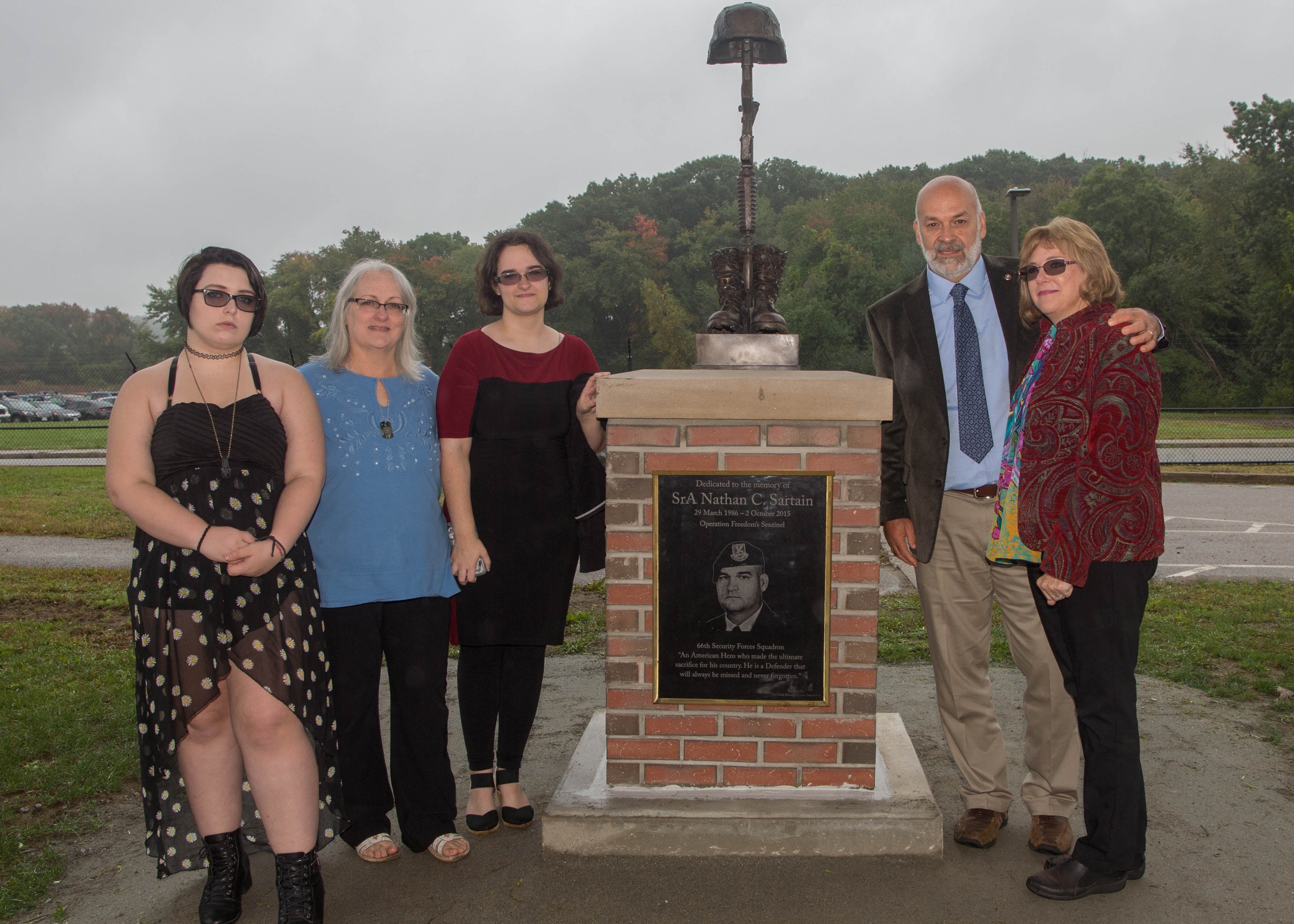 Following a ceremony to dedicate and rename the Senior Airman Nathan Sartain Gate, formerly known as the Vandenberg Gate, Alexia Paulley, from left, Janice, Heather, Phillip and Marlie, all members of the Sartain family, stand beside a memorial at Hanscom Air Force Base, Mass., Oct. 2. The ceremony also renamed the Vandenberg Gate to Senior Airman Nathan Sartain Gate. Both Airmen were killed in 2015 when the C-130J Super Hercules aircraft they were on crashed shortly after takeoff in Afghanistan. (U.S. Air Force photo by Jerry Saslav)
Following a ceremony to dedicate and rename the Senior Airman Nathan Sartain Gate, formerly known as the Vandenberg Gate, Alexia Paulley, from left, Janice, Heather, Phillip and Marlie, all members of the Sartain family, stand beside a memorial at Hanscom Air Force Base, Mass., Oct. 2. The ceremony also renamed the Vandenberg Gate to Senior Airman Nathan Sartain Gate. Both Airmen were killed in 2015 when the C-130J Super Hercules aircraft they were on crashed shortly after takeoff in Afghanistan. (U.S. Air Force photo by Jerry Saslav)
Both security forces Airmen were killed in 2015 when the C-130J Super Hercules aircraft they were on crashed shortly after takeoff in Afghanistan.
Staff Sgt. Wilmer Puello, a member of the 66 SFS who worked with Sartain, spoke about his fellow Airman during the ceremony at the Minuteman Commons.
“He wasn’t just phenomenal on the job, but off the job, too,” said Puello. “He was a fantastic human being.”
Staff Sgt. Nicholas Wright, who deployed with Sartain and Ruiz in 2015, discussed the caliber of people they were.
“They were our family; they were the best people I could have ever asked to be on a deployment team with,” he said.
Wright, who flew with Ruiz prior to her teaming with Sartain, said he could not have asked for a better partner.
“I got to know her well during this time, something I’m very thankful for,” said Wright.
Chief Master Sgt. Henry Hayes, the installation’s command chief, spoke about the Airman’s Creed as it applies to these Airmen.
“They were leaders beyond their age and rank,” he said. “We will never leave these Airmen behind. We will not fail them, their memories, your families or this nation that they loved so dearly.”
Col. Chad Ellsworth, installation commander, mentioned the importance of the ceremony.
“To the Ruiz and Sartain families, thank you for being here today to mark this historic occasion,” he said. “Today marks a day we ensure the character, honor and sacrifice of Nathan and Kcey live on forever, not only through the memories of those whose lives they touched, but as a permanent reminder to all those who enter Hanscom Air Force Base.”
The Hartwell and Vandenberg Gates received their names by direct association to the streets they are on, dedicated during official ceremonies in September 1981 and April 1991 respectively, according to Randy Bergeron, the installation historian.
During the unveiling of plaques at the two newly-named gates, Ellsworth spoke about the legacy left behind by the sentry Airmen who once stood guard at them.
“From this day forward, anyone who enters these gates will know exactly who protects and guards Hanscom Air Force Base,” he said.
AFSFA Note: The black granite plaques mounted at the gates were presented to the 66th Security Forces Squadron Commander by your AFSFA.
Air Force Base Defenders Upgrade Weapons, Training and Fitness Standards to Meet Near-Peer Threats
By: Kyle Rempfer, Air Force Times, 26 November 2018
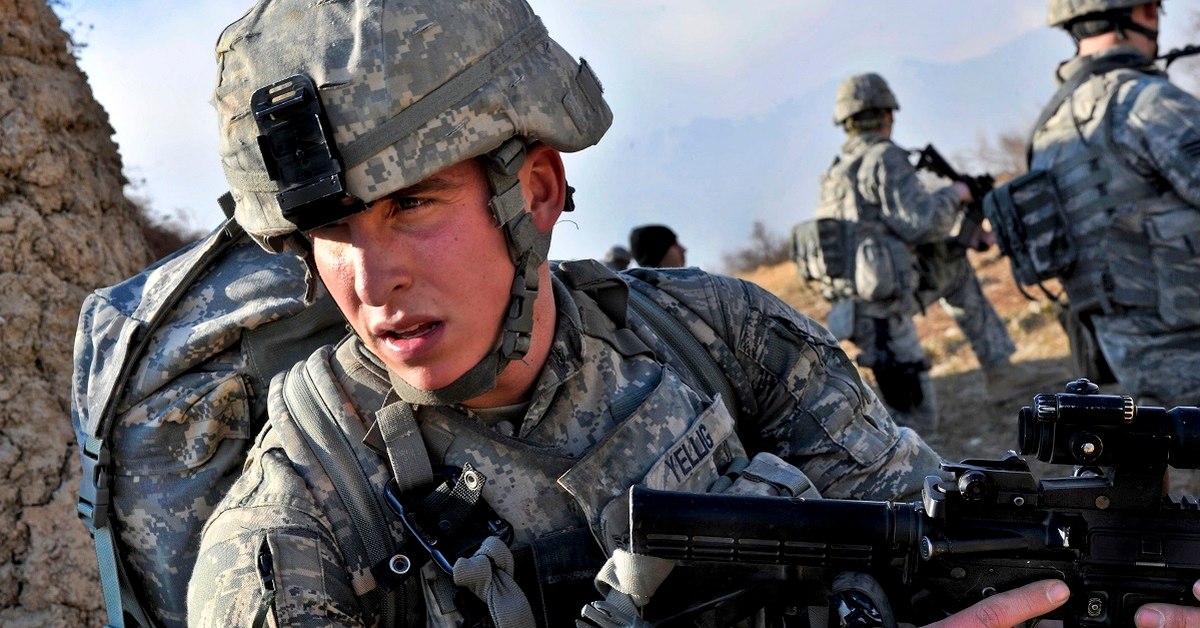
Airmen survey the area during a patrol outside Bagram Airfield, Afghanistan, which features complex, layered defenses. The Air Force is intent on hardening its bases around the world and preparing to protect forward-deployed squadrons in the event of a war with Russia or China. (Senior Airman Sheila deVera/Air Force)
Big changes are coming to the Air Force’s base defenders.
The service’s ability to gain air superiority over a peer adversary could soon hinge on a career field that — like the rest of the U.S. military — has become accustomed to primarily combating violent extremism.
But if a conflict with Russia or China breaks out, the Air Force will not be able to rely solely on the other services' ground combat units to protect its assets. Instead, security forces airmen will have to pick up the slack in safeguarding forward-deployed squadrons, and if necessary, repelling major assaults from outside the wire.
To prepare them for such a responsibility, Air Force leadership is pushing new resources, training guidelines and physical assessments out to its defenders.
As a land-based air component, you got to fight from the base,” Air Force Chief of Staff Gen. Dave Goldfein told Air Force Times. “We have to fight and secure a base before we can get the bombers to where they need to go.”
It’s a lesson Goldfein internalized from his time as the air component commander at U.S. Central Command. One day, he pulled his staff into his office to remind them that while the day-to-day battles might seem far from major air hubs like Bagram Air Base, Afghanistan, or Al Udeid Air Base, Qatar, the threat to airfield defenses was still very real.
“We’re at war against a determined enemy and we may lose airplanes. We may lose airmen. It’s tragic, but it happens,” Goldfein told his commanders. “But here’s what we’re not going to do: We’re not going to have someone get inside our perimeters and wreak havoc on the inside of our base because we weren’t properly defending it.”
In an era of great-power competition, that threat is only magnified. Air Force squadrons may be operating more like the highly mobile flying circuses of World War I, than the stationary airfields of the Global War on Terror.
To accompany that change in operations, units need to be self-sufficient, self-sustaining and self-defending.
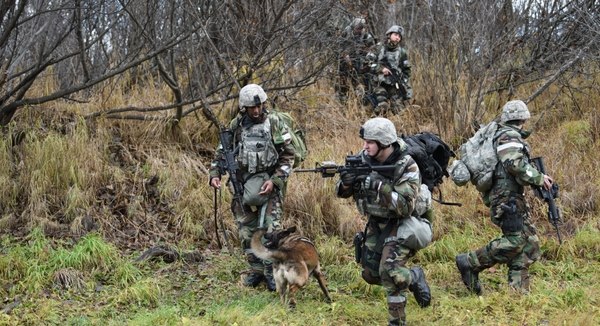
Airmen with the 673rd Security Forces Squadron, participate in shoot move and communicate drills at Joint Base Elmendorf-Richardson, Alaska, Oct. 24. (Jamal Wilson/Air Force)
‘Year of the Defender’
Visitors to Bagram and Kandahar airfields in Afghanistan will notice that the operations centers there oversee a slew of layered defenses — everything from giant blimps with cameras, to security forces airmen on patrol to counter-rocket and mortar systems — which feed into a web of security that protects aircrew flying in and out.
“What we’ve done there is hardened the environment. In attacking the base, you have to get through a lot of layers before you even get to the fence line," Goldfein said. “I’m looking to establish a very similar environment everywhere."
“I’m expecting that if an airman wears a [defender’s] beret, they’re the best in the business,” Goldfein said.
The Air Force is beginning to put a lot of resources into security forces, including upgraded kit and weapons, more practical physical fitness standards and better training under stressful conditions.
"And so we’ve called this the ‘Year of the Defender,’ " Goldfein said.
The Air Force fields roughly 25,000 active-duty security forces airmen, with another 13,000 in the Air National Guard and Reserve components. The total force is about 38,000 airmen — roughly 98 percent of whom are enlisted.
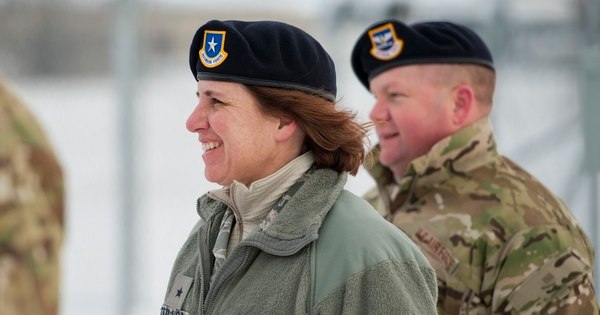
Brig. Gen. Andrea Tullos, director of Security Forces, speaks with base defenders at Minot AFB, N.D., in 2016. “I like to say we bring a “lot of bang for the buck,” she said.
“We size up very similar to the Army’s lightest of the light infantry," said Brig. Gen. Andrea Tullos, the Air Force’s “top cop” and a career security forces officer.
“We have strong expeditionary roots,” she said. "We’re somewhat of a blend between a light infantry unit and a military police company, and we’re not as expensive as a lot of the Air Force’s weapon systems, so I like to say we bring a lot of bang for the buck.”
The service has been working their Year of the Defender initiatives since the 2018 National Defense Strategy came out Jan. 19, highlighting peer adversaries as the most pressing concern for the Pentagon, said Tullos.
“Now, we have to think about defending our bases in the homeland in the same manner that we defend our bases overseas,” she added. “That has been a significant driver for what we’ve done this year so far and what we will continue to do.”
One big initiative has been the modernization of security forces' weapons.
Increased Lethality
Tullos explained that the Air Force is revamping the weapons load-out security forces airmen carry on patrol, largely mirroring changes the Army is undertaking for its soldiers.
“The Air Force has given us funds to accelerate those plans," Tullos said. "That includes our rifle, our handgun, our precision engagement rifle, the optical systems on rifles and grenade launchers.”
Security forces are acquiring the M-18 handgun, a compact version of Sig Sauer’s M-17, which chambers 9 mm ammunition.
Defender airmen are also receiving upgraded M4A1 rifles with a different rail system, a floating barrel and better optics. That way they can transition from the M68 Close Combat Optic to the ACOG system.
That’s a rifle, handgun and optic the Army also uses, increasing the two services' compatibility.
The Air Force is also waiting on testing to finish on their new precision engagement rifle: the M110A1 Semi-Automatic Sniper System.
‘The homeland is no longer a sanctuary’ amid rising near-peer threats, NORTHCOM commander says
“We don’t have a significant inventory of those rifles, because we don’t have a sniper mission, but we do have a counter-sniper mission," Tullos said. "It’s largely in the nuclear enterprise as well as the mission sets you’ll see at bases like Andrews [AFB] outside Washington, D.C.”
The Air Force is also going to acquire the M320 grenade launcher to replace its M203 system. The M320 provides a stand-alone launcher, rather the M203, which is attached to a rifle.
Flipping the Script
New weapons are nothing without better training, however.
“I always say to Goldfein that if I had one more dollar to spend, I’d spend it on training," Tullos said. "You can have the best equipment in the world, but if the airmen don’t know how to effectively utilize it, we could still not succeed.”
Security forces' greatest achievement to date, Tullos said, has been flipping their training model.
“What used to be called predeployment training has become what we call sustainment training,” she said.
Rather than only training up defenders prior to a deployment, the airmen are constantly rotated through training cycles while stateside. Not only does this increase the readiness of stateside units, but it helps give training options for airmen who are considered “deployed-in-place."
“We’re now sending every airman to training at a readiness training center, and ours is at Fort Bliss, Texas, where the training is tailored to the rank and skill-level," Tullos said. "Our NCOs and senior NCOs are getting appropriate troop-leading procedures and maneuver on a scale you would expect an NCO to be doing. Meanwhile, our airmen are doing fire-team level tasks and then they both come together during that training for dismounted and mounted operations so it all comes together.”
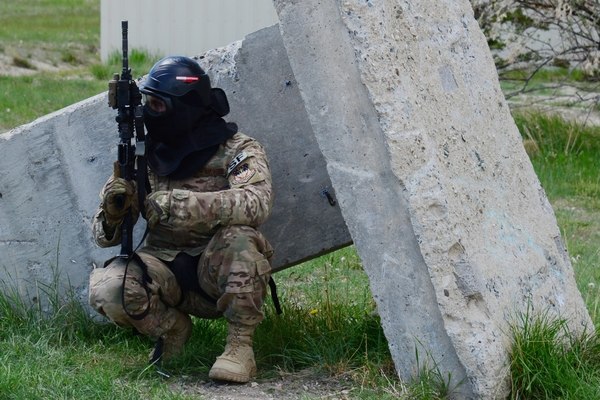
An airman with the 841st Missile Security Forces Squadron takes cover during a training scenario June 24 at Fort Harrison, Montana. (Airman 1st Class Tristan Truesdell/Air Force)
“And they’re getting that episodically in their careers, on a four-year timeline, but if you promote to a new rank and skill-level, we’re going to send you back to training," she added.
The Air Force is only six months into the new model, but so far, about 2,500 security forces airmen have been trained this year. The goal for next year is to get about 5,000 through the training pipeline.
At Home on the Range
The principle line of effort is training, and that starts with technical school.
There, future defenders are now handling their weapons six times more than before the changes were instituted, as well as receiving weapons simulations to learn fundamentals prior to range time.
I’m not going to be happy until our defenders are checking out their weapons before a patrol and going to a range and firing them not once a year, not twice a year, but every day," Goldfein said, "because their weapons need to be sighted and effective, and our airmen need to be confident in their weapon to defend the base.”
The Air Force has also introduced “shoot, move, communicate” training at security forces squadrons, which involves die-cartridges and doesn’t have to be conducted on a firing range.
That enables all NCOs to easily schedule time to train their team, even when ranges aren’t available.
“We’re also looking at getting our airmen to full-distance ranges more frequently,” Tullos said.
Sometimes that will involve TDY trips, because the Army tends to have more full-distance ranges than the Air Force.
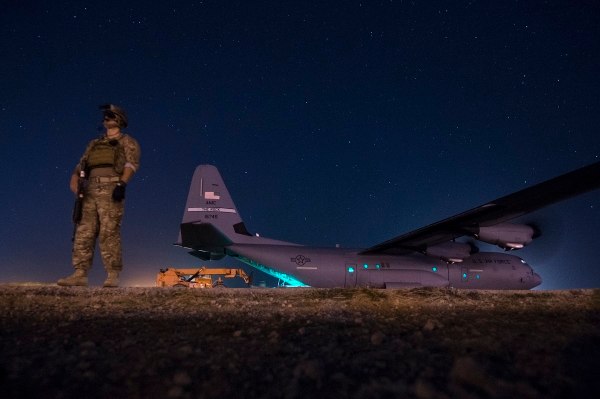
A security team watches over a C-130J in May 2017 during a cargo mission in Somalia in support of Combined Joint Task Force-Horn of Africa. (Master Sgt. Russ Scalf/Air Force)
The Air Force has also resurrected the Defender Challenge, a competition of ground combat skills that was held in San Antonio in September for the first time in 15 years.
“It lets us validate our training, evaluate gaps and go back to change training," Tullos said.
One take-away from September: The marksmanship of each defender went down significantly when the airmen were placed under physical stress like carrying combat loads and receiving simulated contact from enemy forces for distances greater than 200 meters.
That’s related to their discomfort with the system at those distances, so security forces plans to adjust training to reflect that need.
Better, Stronger, Faster
The Air Force also plans to introduce a functional fitness assessment for security forces.
Tullos' department is working with the Air Force Personnel Center and some human performance experts to determine the optimal fitness levels and testing options to assess its airmen.
Security Forces is still determining which exercises will be involved in their new functional fitness test. When they decide, it will take roughly a year of the squadrons implementing those movements to collect enough data to determine what the standards should be.
However, the test will involve things like carrying a load over distance, a dummy drag or dummy carry, moving with a standard combat load up stairs, or even dead lifts.
“Those are movements the performance experts are looking at to see what correlates best with what we do on the job," Tullos said. “Within a two-year timeframe, we expect that we’ll have that approved as our career field fitness test. So that will replace the Air Force fitness test.”
Tullos said it will look similar to what the Army is currently implementing with its new Combat Fitness Test.
Hardening the Base
Finally, the Air Force is undergoing changes to ensure that bases are better defended, both at home and abroad.
Eventually, the service would like to evolve to a point where there is no difference between the force downrange, and the one in garrison, according to Goldfein.
“We would like to bring the communications systems we use when deployed into our units at home,” Tullos said. “We’re going to roll that out at Malmstrom [Air Force Base] and start testing that in April.”
That Will Be a Full Spectrum Communications System

Airmen from the 822 Base Defense Squadron out of Moody, Georgia, stand guard on Tyndall Air Force Base, Florida, after Hurricane Michael swept the area Oct. 20. (Senior Airman Sean Carnes/Air Force)
Tullos expects defenders to eventually have an unclassified portable electronic notebook with them on patrol to access maps and applications that help them plan routes, assess threats and drop pins on suspect activity.
“When we roll out the joint light tactical vehicle — which is our next vehicle system — they’ll have a supportable device receiving downlinks from overhead imagery," Tullos said.
“Our convoys will have the ability to see over the horizon and if they have to go encrypted or secure, they can do so,” she added. "They will be able to bounce back to a commercial backbone, a military backbone or a satellite communication.”
Those are the kinds of capabilities security forces airmen have downrange, but when they come back stateside, they are forced to use an entirely different system.
“We’re at a point where that no longer makes sense — both from the training angle and the costs associated with having two separate communication systems, but also from the standpoint that we can no longer say when we’ll need those increased capabilities," Tullos said.
No one knows how the great power competition will play out in the years ahead. But whatever comes, the Air Force’s base defenders aim to be ready.
********
Kyle Rempfer is the Early Bird Brief Editor for Military Times and a former Air Force combat controller.
 Col (ret) Nicholas (Nick) Keck passed on 23 November 2018. He served 30 years on active duty from 1959-1989 as a Provost Marshal; Minuteman Missile Senior Standardization Crew member, 4-time Squadron Commander (last as 89th SPS responsible for Presidential Aircraft security); Director of Resources Management at 12AF, HQ TAC, and HQ USAF; RAF Regiment Exchange Officer; Air War College Student; Professor of Aerospace Sciences, Kent State Univ; Chief Security Police, HQ Air Training Command and served a tour in Vietnam and Thailand. Nick was a Founding and Life Member of AFSFA. He edited Tiger Flight for 15 years, served on the Board of Directors for two terms, was the AFSFA Secretary and the first inductee into the AFSFA Hall of Fame in 2008 and the only active duty member present at the founding of our Association. Nick’s contagious smile and laugh and candor will be sorely missed. Nick is survived by his wife Felice and their two children, Kristopher and Nicole.
Col (ret) Nicholas (Nick) Keck passed on 23 November 2018. He served 30 years on active duty from 1959-1989 as a Provost Marshal; Minuteman Missile Senior Standardization Crew member, 4-time Squadron Commander (last as 89th SPS responsible for Presidential Aircraft security); Director of Resources Management at 12AF, HQ TAC, and HQ USAF; RAF Regiment Exchange Officer; Air War College Student; Professor of Aerospace Sciences, Kent State Univ; Chief Security Police, HQ Air Training Command and served a tour in Vietnam and Thailand. Nick was a Founding and Life Member of AFSFA. He edited Tiger Flight for 15 years, served on the Board of Directors for two terms, was the AFSFA Secretary and the first inductee into the AFSFA Hall of Fame in 2008 and the only active duty member present at the founding of our Association. Nick’s contagious smile and laugh and candor will be sorely missed. Nick is survived by his wife Felice and their two children, Kristopher and Nicole.
Page 25 of 50


